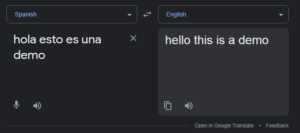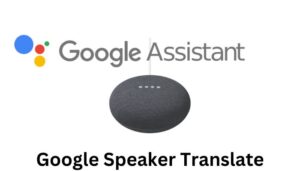Google Speaker Translate
Since the days of clunky, rule-based systems that struggled to produce accurate translations, translation technology has come a long way. Thanks to the advent of machine learning and artificial intelligence, we now have access to more sophisticated translation techniques that can easily handle complex language tasks. And one of the most exciting of these technologies is Google Speaker Translate.
Google Speaker Translate is a system that uses neural machine translation to provide fast, accurate translations between a wide range of languages. Whether you’re travelling in a foreign country or trying to communicate with someone who speaks another language, Google Speaker Translate is a powerful tool that can help you break down language barriers and connect with people worldwide.

But how did we get here? What were the early developments in translation technology, and how did we get to the current state of the art? In this article, we’ll take a look at the evolution of translation technology and explore the unique features and capabilities of Google Speaker Translate.
Now, before we dive into the technical details, let’s take a moment to appreciate how incredible it is to communicate with people from all over the world, even if we don’t share a common language. It’s a testament to the power of technology and human ingenuity, which we should all be grateful for.
So, let’s take a trip down the history of translation technology and see how we got to this remarkable point in time.
The History of Translation Technology
Translation technology has come a long way since its earliest days, which can be traced back to the 17th century. The first attempts at translation machines consisted of devices with gears, pulleys and cranks that were far from perfect. Over time, many advances have been made in translation technology, from rule-based systems to neural machine translation.
One of the latest and most advanced examples of translation technology is Google Speaker Translate, which allows you to communicate with someone in another language in real-time, even recognizing different accents and dialects. This technology is like having a multilingual interpreter in your pocket.
But even with all the progress, challenges still exist, such as handling nuance and context. However, it is clear that translation technology has made significant advances and will undoubtedly continue to evolve as technology advances.
So, as we take a look back at the history of translation technology, let’s take a moment to appreciate how far we’ve come. And who knows, maybe one day we’ll have technology that can even pick up on the nuances of sarcasm and humour in languages. One can only dream, right?
Here are some key points of Translation technology’s history
- Rule-based translation: This point refers to early forms of translation technology, which were largely rule-based. These systems rely on simple algorithms and rules, often based on grammar and syntax. They could not handle complex language structures, such as idiomatic expressions and cultural references.
- The Rise of Machine Translation: Machine translation marked a significant step forward from rule-based systems, using advanced algorithms to recognize patterns in language and produce more accurate translations. This development began in the mid-20th century with the development of the Georgetown–IBM experiment, which used an electronic computer to translate Russian into English.
- Limitations of early machine translation systems: While early machine translation systems could generate translations, they often seemed stilted and unnatural due to their inability to recognize context and nuance. As a result, the accuracy of these early systems was limited, and they were unable to translate more complex language structures, such as idiomatic expressions and cultural references.
- Statistical Machine Translation: Statistical machine translation (SMT) began in the 1980s and 1990s, providing more accurate translations. SMT used large amounts of data to train algorithms to identify patterns in language use. This resulted in more accurate translations that sounded more natural and fluent.
- The Challenges of Balancing: Despite the improvements provided by SMT, early translation systems were still unable to accurately translate complex language structures, such as idiomatic expressions and cultural contexts. These are still some of the biggest challenges in translation technology today, and more sophisticated algorithms are needed to overcome them.
- Neural Machine Translation: The development of neural machine translation (NMT) in the early 2010s marked a turning point in translation technology. NMT uses deep learning algorithms to recognize complex patterns in the language and produce more natural and nuanced translations. As a result, NMT is more accurate and fluent than previous systems.
- Google Speaker Translate: Google Speaker Translate is an example of how far translation technology has come. This real-time translation system uses highly intuitive and user-friendly technology to break language barriers and promote global communication. With Speaker Translate, users can get real-time speech translation in over 100 languages.
- The impact and future of translation technology: The impact of translation technology is already significant, breaking down language barriers and fostering cross-cultural communication. As technology continues to improve, translation technology will likely become even more accurate and effective, making communication easier for people worldwide.
- Ethical considerations: Like any technological advancement, there are ethical considerations to consider when it comes to translation technology. Accuracy, bias and confidentiality are important issues to consider, as translations can significantly impact people’s lives and livelihoods.
The history of translation technology is one of constant progress and constant innovation. While there are still significant challenges to be overcome, the development of NMT has ushered in a new era of translation technology that holds great promise for breaking down language barriers and promoting global communication. As we look to the future, it will be interesting to see how translation technology develops and impacts the world.
The Emergence of Neural Machine Translation
In the world of translation technology, Neural Machine Translation (NMT) is like the new kid everyone wants to hang out with at school. It is the product of breakthroughs in machine learning and artificial intelligence that have allowed it to handle more complex translation tasks and provide more accurate and nuanced translations than its predecessors. Go ahead, rule-based and statistical machine translation; there’s a new player in town!
But what makes NMT so unique, you ask? Well, it has all the proper steps, such as understanding the context and nuances of language, recognising idiomatic expressions and cultural references, and generating more fluent and natural-sounding translations. It’s like the high school quarterback who could easily throw a touchdown pass while acing his AP calculus exam.
Of course, like any high school kid, NMT isn’t perfect. It still has growing pains, like dealing with complex sentence structures and accurately translating idioms that even humans struggle with. But hey, Rome wasn’t built in a day, and neither was perfect translation technology.
So, let’s take a closer look at the emergence of neural machine translation and what makes it so exciting (and cool) in the world of translation technology.
- NMT has grown due to machine learning and artificial intelligence breakthroughs. These breakthroughs include the development of deep learning techniques, which enable computers to learn from large amounts of data and make predictions based on that learning.
- NMT uses artificial neural networks, which are modelled after the human brain, to generate translations. This allows NMT to understand the context and nuances of the language and provide more accurate and nuanced translations.
- In NMT, artificial neural networks are trained on large datasets of parallel texts, which are texts that are translations of each other in different languages. This allows the system to learn how to translate phrases and sentences accurately and fluently.
- NMT can handle more complex translation tasks than previous machine translation methods. This is because the artificial neural networks in NMT can recognize and translate idiomatic expressions, slang and cultural references that are difficult for other machine translation methods to handle.
- NMT can also provide more accurate and precise translations than previous machine translation methods. This is because the artificial neural networks in NMT take into account the context of a sentence and the relationships between words, allowing the system to generate translations that accurately capture the original text’s meaning.
- NMT can also generate translations that are more fluent and natural-sounding than those produced by previous machine translation methods. This is because the artificial neural networks in NMT consider the structure of sentences and how words relate to each other, leading to more coherent translation.
- However, NMT is not perfect, and there are still limits to its ability to generate accurate and precise translations. For example, NMT may struggle with rare or specialized vocabulary, and fine-tuning the system for specific languages or domains may be difficult.
- Despite these limitations, NMT represents a significant advance in translation technology. Its ability to handle more complex translation tasks and provide more accurate and nuanced translations has significantly impacted the e-commerce, travel and customer service industries. It is expected to continue to grow in importance in the future.
Google Speaker Translate: An Overview
Let’s face it, trying to communicate with someone who speaks a different language can sometimes feel like trying to teach a cat to play the piano – it’s not going to happen. Is. But fear not, and Google has you covered with its speaker translation. It’s like having a personal language genie in your pocket, ready to satisfy your desire for multilingual communication.
Speaker Translate has an impressive range of features, such as the ability to translate speech in real-time, and a sleek, lightweight design that won’t weigh you down like a bag of bricks. It’s like having a language superhero you can take with you wherever you go, ready to save the day when you need it most.
So, how does this magical device work, you ask? Well, it’s all thanks to the power of machine learning and artificial intelligence, which allows Speaker Translate to recognize and translate spoken language in real-time. It’s like having a super-smart, multilingual robot sidekick that can interpret your every word and translate it on the fly.
But don’t worry; this language superhero isn’t here to replace human interpreters – it’s here to help make communication easier and more accessible to everyone. Plus, it’s a lot less awkward than playing the stork to try to get your point across.
So, let’s take a closer look at Google Speaker Translate and see what makes it so special in the world of translation technology.
The Advantages of Google Speaker Translate
Google Speaker Translate is an advanced translation tool that offers several advantages over traditional translation methods. Below are some of the key benefits of using this technology:
- Enhanced accuracy: Google Speaker Translate uses neural machine translation technology to provide more precise and accurate translations than many other translation tools. This is because the technology can recognize and translate a given conversation’s context, which helps ensure that translations are more accurate and natural-sounding.
- Ease of use: The device is designed to be user-friendly and easy to operate, making it accessible to people from a wide range of backgrounds. Its simple interface and intuitive controls allow users to easily initiate translation and adjust settings as needed.
- Portability: The device is small and compact, making it easy to take it with you wherever you go. This makes it an ideal tool for travellers who want to communicate with locals in a foreign country or for business professionals who need to communicate with clients and colleagues from different parts of the world.
- Versatility: Google Speaker Translate can be used in various situations, making it a valuable tool for breaking down language barriers and facilitating communication across cultures. Whether you’re trying to order food at a restaurant, communicating with a healthcare provider, or collaborating with colleagues from different parts of the world, technology can help you overcome language barriers and communicate more effectively. Communicating effectively can help.
- Multilingual Support: The device supports a wide range of languages, making it a powerful tool for communicating with people from different parts of the world. This feature is handy for travellers and business professionals who may need to communicate with people who speak different languages.
- Real-time translation: Google Speaker Translate can provide real-time translation of conversations, allowing people to communicate with each other in real-time without needing a human translator. This can be especially useful when time is of the essence, such as in emergencies or business negotiations.
Overall, Google Speaker Translate is a powerful tool that offers a range of advantages over traditional translation methods. From its increased accuracy and ease of use to its versatility and multilingual support, this technology is well-positioned to help overcome language barriers and facilitate communication across cultures.
Examples of situations where the technology has proven useful.
Language barriers can be frustrating, especially when you are in a foreign country desperately trying to ask for directions to the nearest restroom. Fortunately, with the advent of Google’s speaker translation, miscommunication due to language barriers is a thing of the past. This innovative technology allows users to communicate with others in real-time, even if they speak different languages.
But how useful is Google’s speaker translation? Let’s take a closer look at real-life situations where technology has saved the day. From business meetings to medical emergencies, Google Speaker Translate has proven to be a valuable tool for bridging communication gaps and bringing people closer together.
So, sit back, relax, and prepare to be amazed at the ways this clever little technology has made the world a smaller and more connected place. Who knows? After reading about the countless situations where Google Speaker Translate has come in handy, you might feel inspired to learn a new language — or at least download the app before your next trip abroad.
Here are some examples of situations where Google’s speaker translation technology has proved useful:
- Travel: When travelling to a foreign country, communicating with the locals can be challenging, especially when there is a language barrier. Google Speaker Translate helps travellers communicate with locals by instantly translating spoken conversations, making it easier to navigate new places.
- Business Meetings: It is common to have business partners or customers from different countries speaking different languages in today’s global economy. Google Speaker Translate makes it easy to communicate with them during virtual meetings or in-person meetings, allowing for seamless communication despite language differences.
- Education: With the rise of online education and e-learning, Google Speaker Translate can help facilitate communication between students and teachers who speak different languages. This can be especially helpful in language learning, where students can practice their language skills by interacting with native speakers.
- Medical services: In situations with a language barrier between doctors and patients, Google Speaker Translate can help facilitate communication and improve patient care. For example, medical professionals can use technology to instruct patients on how to take medications or explain medical procedures in a language the patient understands.
- Emergencies: In emergency situations, time is of the essence, and miscommunication can have dire consequences. Google Speaker Translate can help emergency responders communicate quickly with people who speak different languages, ensuring that important information is delivered accurately and efficiently.
The Limitations of Google Speaker Translate
Google Speaker Translate is undoubtedly a game-changer in breaking down language barriers and facilitating communication between people from different parts of the world. However, like any technology, it has its limits. Here are some of the challenges and drawbacks to be aware of when using this innovative tool.
- Accuracy: While Google’s speaker translation has made impressive strides in accuracy, it’s not perfect. The technology still struggles with nuanced, colloquial and context-based translations. This can also lead to awkward or inaccurate translations, especially in more complex conversations.
- Internet connectivity: One of the most significant limitations of Google’s speaker translation is that it relies on an Internet connection to function. This means the technology may not work in areas with limited or no internet connectivity, which can be a significant issue for travelers or people in remote locations.
- Battery life: Like any technology that relies on a battery, Google’s speaker translation has limits on battery life. If you’re using the app for extended periods of time or in situations where you can’t recharge your device, you may experience technology shutdown or unresponsive issues.
- Regional Dialects and Accents: While Google Speaker Translate supports many different languages, it can struggle with regional dialects and accents. This can make it challenging to understand people from certain regions or countries, even if they speak the same language as you.
- Privacy concerns: Like any tool that uses speech recognition and artificial intelligence, Google’s speaker translation raises some privacy concerns. Users may be concerned about the security of their conversations or the possibility of their data being used for advertising purposes.
While Google’s speaker translation is an impressive technology, it’s important to know its limitations and potential drawbacks. By understanding these challenges, users can make more informed decisions about when and how to use an app and better manage their expectations about its capabilities.
Privacy Concerns and Controversies
Google’s speaker translation is a potent tool for breaking down language barriers, but its use has also raised privacy concerns and controversy. Here are some key points
- Privacy concerns: Some people worry that Google is listening in on their conversations or using their voice recordings for other purposes. Others worry that the data collected by Google could be misused or hacked by cybercriminals.
- Controversy: There have been many controversies surrounding Google’s use of Speaker Translate, such as the potential for the technology to be used to aid government surveillance or criminal investigations.
- Steps taken by Google: In response to these concerns, Google has taken several steps to ensure the privacy of its users. For example, it has implemented stronger security measures to guard against cyberattacks and has promised to use voice recordings only to improve technology.
- Additional Measures: Google has also made it easier for users to control their data by implementing features like “Incognito Mode” and “My Activity”. These features give users more control over their data and the ability to limit the information that is shared.
- Controversy over government surveillance: There has been controversy surrounding Google’s willingness to comply with government surveillance requests. However, Google has stated that it only complies with legal requests and has taken steps against inappropriate requests.
While there are certainly privacy concerns and controversies surrounding Google’s use of speaker translate, it is important to recognize the steps Google has taken to address these concerns. As with any technology, users should be careful with their personal data and ensure they understand the privacy policies of any products they use.
The Future of Translation Technology
As technology continues to advance rapidly, the future of translation technology is an exciting and promising area to explore. With the potential of more advanced artificial intelligence and machine learning systems, the ability of translation technologies to communicate accurately and efficiently across languages and cultures is becoming a reality increasingly.
The impact of these developments could be substantial, potentially changing how we communicate with each other and how businesses and organizations operate on a global scale.
In this context, it is worth examining the future of translation technology and the potential implications for existing systems such as Google’s speaker translation. Here are some key points
- Advances in AI and Machine Learning: As technology continues to evolve, we can expect to see more advanced AI and machine learning systems in the field of translation technology. These advances can lead to significant improvements in accuracy, speed and flexibility.
- More complex translations: As translation technology becomes more advanced, it will be able to handle more complex translations. This will allow for greater precision and accuracy, especially in fields such as business, law, and medicine.
- Ease of use: As translation technology becomes more user-friendly, it will become more accessible to a wider range of people. This would allow for more global communication and collaboration.
- Better Access: Advances in technology will also allow greater access for people with disabilities. This may involve developing translation technology for sign language or speech-to-text translation.
- Impact on Google Speaker Translate: As other translation technologies continue to develop, Google Speaker Translate may face increased competition. However, it is also likely that Google will continue to invest in technology to ensure that it remains at the forefront of the industry.
- Ethical concerns: With the development of more advanced AI and machine learning systems, there will also be ethical concerns regarding issues such as data privacy, bias, and the impact on human translators. It will be important for the industry to address these concerns as technology evolves.
Overall, the future of translation technology looks promising, with potential advances that could significantly improve global communication and collaboration. However, ethical concerns will also need to be addressed as the technology develops.
Tips for Using Google Speaker Translate
Google Speaker Translate is a powerful tool that can provide quick and accurate translations in various languages. However, to use it effectively, it is necessary to keep a few tips in mind. This explanation will cover some practical tips for using Google Speaker Translate effectively.
- Use the system in a quiet environment: To get the most accurate translation, it’s best to use Google Speaker Translate in a quiet environment. Background noise may interfere with the system’s ability to recognize and translate your speech.
- Speak clearly and at a moderate pace: When using Google Speaker Translate, it is important to speak clearly and at a moderate pace. This can help the system to recognize better and translate your speech.
- Avoid complex sentence structures: While Google Speaker Translate can handle some level of complexity, it is best to avoid using overly complex sentence structures when using the system. This can help ensure a more accurate translation.
- Take advantage of the system’s offline mode: Google Speaker Translate can be used offline, especially when travelling in areas with limited or no internet access. Be sure to download the required language packs ahead of time.
- Use the system to practice your pronunciation: Google Speaker Translate can be useful for practising your pronunciation in another language. Just speak into the system and listen to the translation to get an idea of how well you’re doing.
With these tips in mind, you can use Google Speaker Translate more effectively and get the most out of this powerful translation tool.
In short, the emergence of translation technology has made it easier for people worldwide to communicate and share information. Google’s speaker translation is a technology that offers many benefits, such as increased accuracy, ease of use, and accessibility. However, like any technology, it also has its limitations and is prone to errors or inaccuracies. Additionally, concerns have been raised about privacy and data protection, with companies like Google taking steps to address these issues.
Looking to the future, we can expect continued growth and innovation in translation technology, including more advanced AI and machine learning systems. As these technologies become more sophisticated, they have the potential to revolutionize the way we communicate, regardless of language barriers. However, even with the most advanced technology, it is important to remember that accurate and effective translation requires a deep understanding of the language and culture.
In today’s globalized world, where business, travel and social interactions span borders and languages, accurate and accessible translation technology is more important than ever. By using practical tips and best practices, such as how to use Google Speaker Translate effectively, we can ensure that we use this technology to overcome language barriers and promote greater understanding and communication.
You can also read our other articles.


